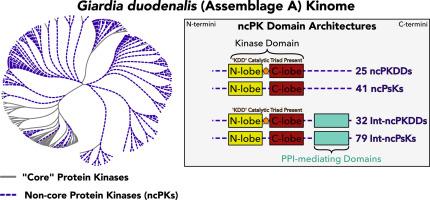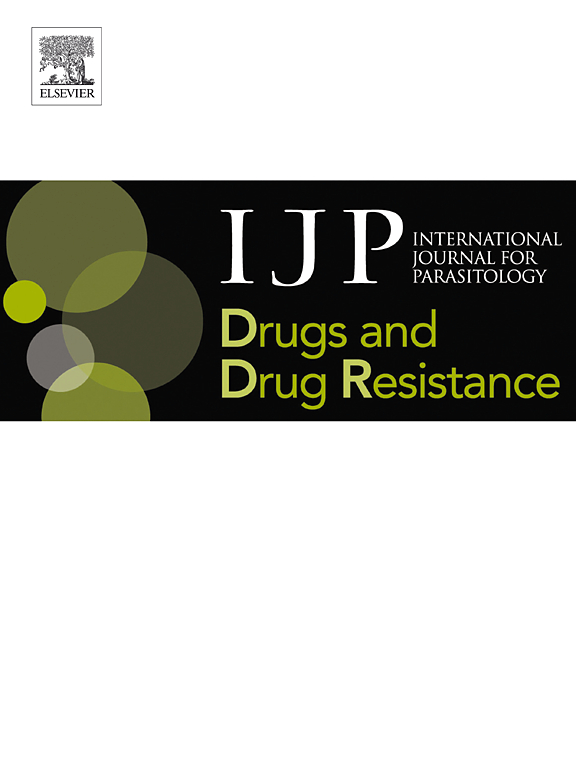Illuminating the druggability of the Giardia duodenalis kinome through reannotation and high-throughput screens
IF 3.4
2区 医学
Q1 PARASITOLOGY
International Journal for Parasitology: Drugs and Drug Resistance
Pub Date : 2025-10-04
DOI:10.1016/j.ijpddr.2025.100619
引用次数: 0
Abstract
Giardia duodenalis (syn Giardia intestinalis, Giardia lamblia) is a neglected, microaerophilic gastrointestinal parasite reliant on broad spectrum anti-microaerophilic/-anaerobic nitroheterocyclic antibiotics (metronidazole) which have been in use for over 70 years. New drugs which avoid their predecessor’s shortfalls of toxic and adverse effects, as well as circumvent its increasing treatment failure, are urgently required to lower global rates of up to 200 million symptomatic cases annually. Kinases are essential regulatory enzymes that primarily catalyse the phosphorylation post-translational modification involved in dynamic cellular processes. Kinases are well-validated and attractive drug targets, with many kinase inhibitors demonstrating great success in the clinic as anticancer therapeutics. In G. duodenalis, its intriguing set of minimal “core” protein kinases and the highly expanded Giardia-specific Never-in-Mitosis-A related kinases (Neks) emerge as a novel druggable space. We propose this kinome as an understudied and underutilised space to explore novel antigiardial targets. Intriguingly, despite over 15 years of advances in kinase biology and new annotation tools, there are limited functional evidence on the existence of ‘Neks’ in G. duodenalis. To incentivise new efforts, we provide an updated kinome reannotation and examination of the giardial core and specific sub-kinomes using novel bioinformatic tools, suggesting a nomenclature and providing insights in a drug-discovery context. Lastly, we have conducted a high-throughput screening of 430 compounds, covering 53 kinase targets and 51 chemical scaffolds, identifying 83/430 antigiardial kinase inhibitors of which 33 true positives could be validated in a subset subjected to drug-susceptibility testing, highlighting intriguing spaces for further development and molecular probes to further explore kinase regulatory pathways in this parasite.

通过重新注释和高通量筛选阐明十二指肠贾第鞭毛虫kinome的药物性。
十二指肠贾第鞭毛虫(又称肠贾第鞭毛虫,兰贾第鞭毛虫)是一种被忽视的、嗜微气的胃肠道寄生虫,依赖于广谱抗嗜微气/厌氧硝基杂环抗生素(甲硝唑),甲硝唑已被使用了70多年。迫切需要能够避免其前身毒副作用不足以及避免其日益增加的治疗失败的新药,以降低全球每年高达2亿有症状病例的发生率。激酶是基本的调节酶,主要催化磷酸化翻译后修饰参与动态细胞过程。激酶是经过充分验证和有吸引力的药物靶点,许多激酶抑制剂在临床抗癌治疗中表现出巨大的成功。在G. duodenalis中,其有趣的最小“核心”蛋白激酶和高度扩展的贾第鞭毛虫特异性Never-in-Mitosis-A相关激酶(Neks)成为一个新的药物空间。我们提出这个基因组作为一个未充分研究和未充分利用的空间来探索新的抗心绞痛靶点。有趣的是,尽管在激酶生物学和新的注释工具方面取得了超过15年的进展,但关于G. duodenalis中“Neks”存在的功能证据有限。为了激励新的努力,我们使用新的生物信息学工具提供了更新的kinome重新注释和对gi心包核心和特定亚kinome的检查,建议命名并在药物发现背景下提供见解。最后,我们对430种化合物进行了高通量筛选,涵盖53种激酶靶点和51种化学支架,鉴定出83/430种抗心包激酶抑制剂,其中33种可在药敏试验中验证为真阳性,突出了进一步开发和分子探针进一步探索该寄生虫激酶调控途径的有趣空间。
本文章由计算机程序翻译,如有差异,请以英文原文为准。
求助全文
约1分钟内获得全文
求助全文
来源期刊

International Journal for Parasitology: Drugs and Drug Resistance
PARASITOLOGY-PHARMACOLOGY & PHARMACY
CiteScore
7.90
自引率
7.50%
发文量
31
审稿时长
48 days
期刊介绍:
The International Journal for Parasitology – Drugs and Drug Resistance is one of a series of specialist, open access journals launched by the International Journal for Parasitology. It publishes the results of original research in the area of anti-parasite drug identification, development and evaluation, and parasite drug resistance. The journal also covers research into natural products as anti-parasitic agents, and bioactive parasite products. Studies can be aimed at unicellular or multicellular parasites of human or veterinary importance.
 求助内容:
求助内容: 应助结果提醒方式:
应助结果提醒方式:


